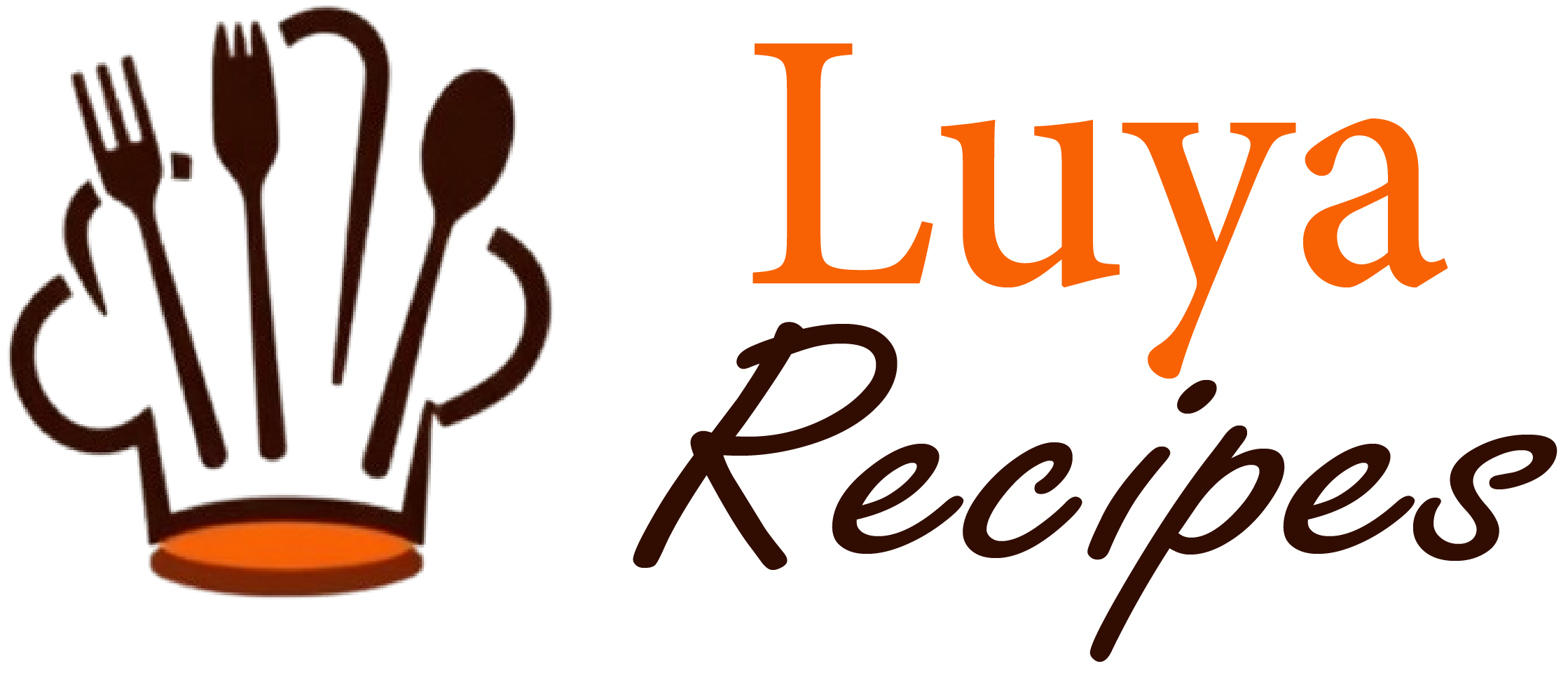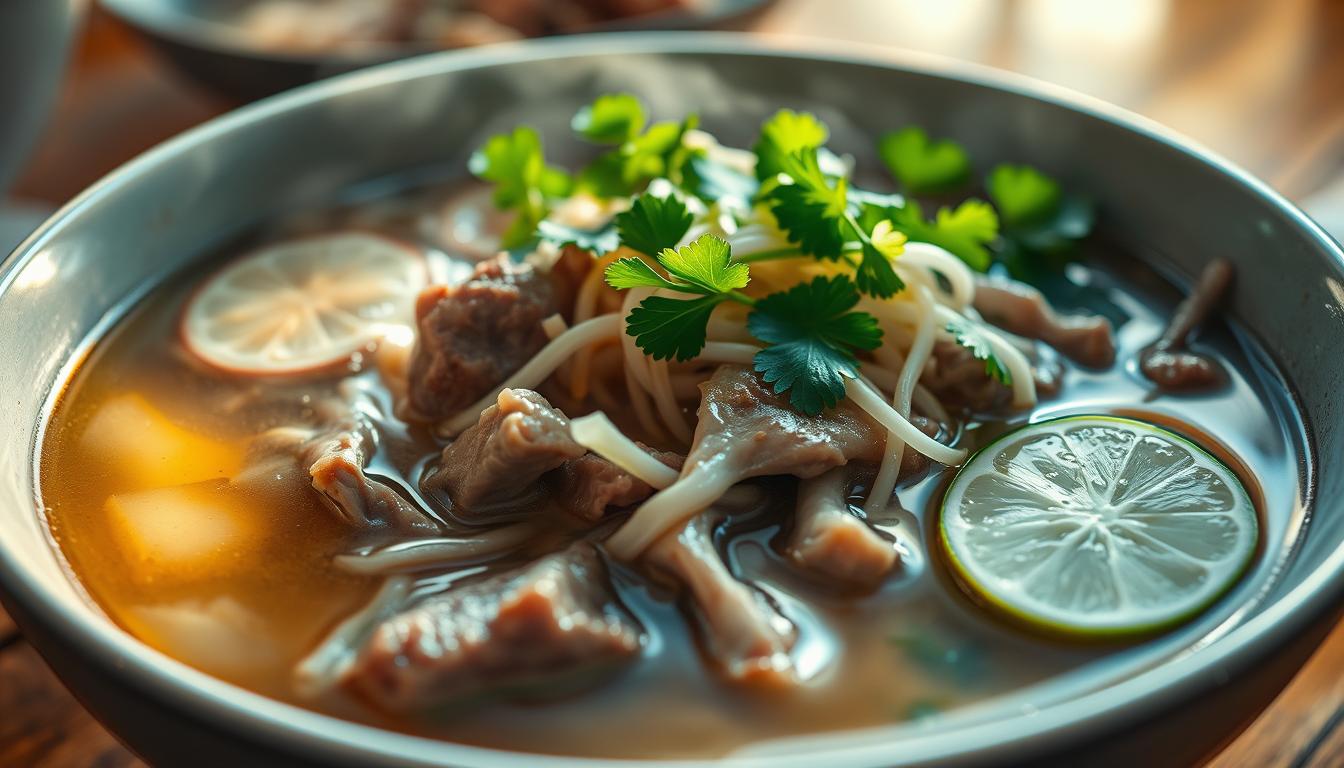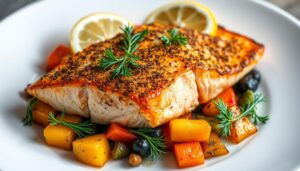Every food lover knows that moment when a single dish can transport you across continents. For me, tendon beef pho is more than just a meal. It’s a journey through Vietnamese cuisine that awakens every sense. The rich, aromatic broth, tender beef tendons, and delicate rice noodles create an experience that goes beyond simple eating.
Tendon beef pho isn’t just a soup; it’s a cultural narrative simmered to perfection. When you first encounter this extraordinary Vietnamese dish, you’ll understand why food enthusiasts worldwide have fallen in love with its complex flavors and comforting warmth. From bustling street markets in Hanoi to trendy restaurants in San Francisco, this beloved dish continues to captivate taste buds.
Whether you’re a curious food adventurer or someone seeking authentic Vietnamese cuisine, tendon beef pho promises an unforgettable gastronomic experience. Prepare to discover a world of flavor that will challenge everything you thought you knew about soup.
Table of Contents
A Brief History of Vietnamese Pho and Its Cultural Significance
Traditional pho is more than just a meal. It’s a story of cultural strength, culinary creativity, and national pride. This dish has won the hearts of food lovers everywhere.
The history of pho goes back to Northern Vietnam. It started as a street food in the early 1900s. Chefs and home cooks made it during big social and economic changes.
Origins in Northern Vietnam
Vietnamese food is known for its complex flavors. Pho is a perfect example. It came from Hanoi, mixing French and Vietnamese cooking styles.
- Developed in early 1900s
- Primarily created in Northern Vietnam
- Influenced by French colonial cuisine
- Reflected local ingredient availability
Evolution Through Generations
As Vietnamese families moved, pho changed. Each generation added their own twist. These changes kept the dish’s heart while showing local tastes.
Global Influence on Modern Cuisine
Now, pho is loved all over the world. Restaurants everywhere celebrate this tasty noodle soup. It shows how much people love it.
| Era | Culinary Significance |
|---|---|
| Early 1900s | Local Street Food in Hanoi |
| Mid-20th Century | Regional Vietnamese Specialty |
| 21st Century | International Culinary Sensation |
Pho’s journey shows the strength and creativity of Vietnamese food. It went from a simple street food to a beloved dish worldwide. It still inspires chefs and food lovers today.
What Makes Tendon Beef Pho Special
Tendon beef pho is a special dish that turns a simple soup into a unique culinary adventure. The key ingredient, beef tendon, adds a special texture and flavor. This makes it stand out from other beef soups.
Exploring tendon beef pho reveals several unique qualities:
- Rich, gelatinous texture that melts in your mouth
- Intense beef flavor concentrated in the tender meat
- Nutritional benefits from collagen-rich tendons
- Complex layering of traditional Vietnamese spices
The secret to beef tendon soup is in its careful preparation. Chefs cook the beef tendons slowly for hours. This makes them soft yet still firm, and they soak up the broth’s flavors.
| Characteristic | Unique Quality |
|---|---|
| Texture | Soft, gelatinous, with slight resistance |
| Flavor Profile | Deep beef essence with subtle spice undertones |
| Nutritional Value | High protein, collagen-rich |
Pho lovers enjoy tendon beef pho for its true taste and the skill it takes to make. Using top-quality beef tendons, it turns a basic soup into a gourmet dish. It honors Vietnamese cooking traditions.
Essential Ingredients for Authentic Tendon Beef Pho
Making authentic pho requires choosing top-notch ingredients. The secret to great beef noodles is the mix of fresh parts. They add depth and complexity to this beloved Vietnamese dish.
Starting your journey to make perfect tendon beef pho means knowing the key elements. These elements make the dish truly special.
Premium Beef Cuts and Tendons
Choosing the right beef is key for authentic pho. Here are the top cuts:
- Brisket: Rich and flavorful
- Tendon: Adds unique texture and richness
- Sirloin: Lean and tender meat
- Oxtail: Provides deep, robust flavor
Aromatic Spices and Herbs
The heart of beef noodles is its aroma. Key spices include:
- Star anise
- Cinnamon sticks
- Cloves
- Fresh ginger
- Cardamom pods
Noodle Selection Guide
Choosing the right noodles is crucial for authentic pho. Rice noodles are the traditional choice. Here are some tips:
- Fresh rice noodles for optimal texture
- Flat, medium-width noodles
- Avoid overcooking to maintain perfect consistency
By picking each ingredient with care, you’ll make beef noodles that feel like a trip to Vietnam.
The Art of Preparing Beef Tendons
Preparing beef tendons for authentic tendon beef pho needs skill and patience. These tough cuts become delicious through careful cooking. This unlocks their unique texture and flavor.
To prepare beef tendons, follow a precise method:
- Clean the tendons under cold water
- Remove excess fat and connective tissue
- Blanch tendons in boiling water to remove impurities
- Slow-cook tendons for maximum tenderness
The secret to perfect beef tendon preparation is understanding its culinary properties. Slow, gentle cooking breaks down collagen. This creates a melt-in-your-mouth texture that’s key to great tendon beef pho.
| Cooking Stage | Duration | Temperature |
|---|---|---|
| Initial Blanching | 5-7 minutes | Boiling (212°F) |
| Slow Cooking | 2-3 hours | Low (180-200°F) |
| Resting | 30 minutes | Room Temperature |
Professional chefs suggest cutting tendons into bite-sized pieces before adding them to your pho. This ensures even cooking and makes eating easier. It creates a delightful dining experience that highlights the rich, gelatinous nature of beef tendons.
“Mastering beef tendon preparation is an art that elevates your pho from good to extraordinary.” – Vietnamese Culinary Expert
Mastering the Perfect Pho Broth
Making an authentic pho broth is an art that needs patience and skill. It turns a simple meal into a special experience, like being in Vietnam.
The heart of great pho is its broth. A top-notch homemade pho broth needs focus on key elements. These elements make the dish truly special.
Bone Selection Tips
Choosing the right bones is key for a rich, flavorful pho broth. Here are your best picks:
- Beef knuckle bones for gelatin and body
- Marrow bones for depth of flavor
- Oxtail for additional richness
Simmering Techniques
Proper simmering brings out the best flavors from your bones. Follow these steps for a true pho recipe:
- Start with cold water to remove impurities
- Skim foam continuously during initial boiling
- Maintain a gentle, consistent simmer
- Cook for 6-8 hours to develop complex flavors
Seasoning Secrets
The secret to a great pho recipe is in its seasonings. Here are the must-haves:
| Spice | Purpose | Quantity |
|---|---|---|
| Star Anise | Adds warmth and depth | 3-4 whole stars |
| Cinnamon Stick | Provides subtle sweetness | 1 medium stick |
| Charred Ginger | Enhances aromatic profile | 2-3 inch piece |
Creating the perfect homemade pho broth is all about patience and passion. Every step leads to a rewarding culinary adventure.
Traditional Garnishes and Condiments
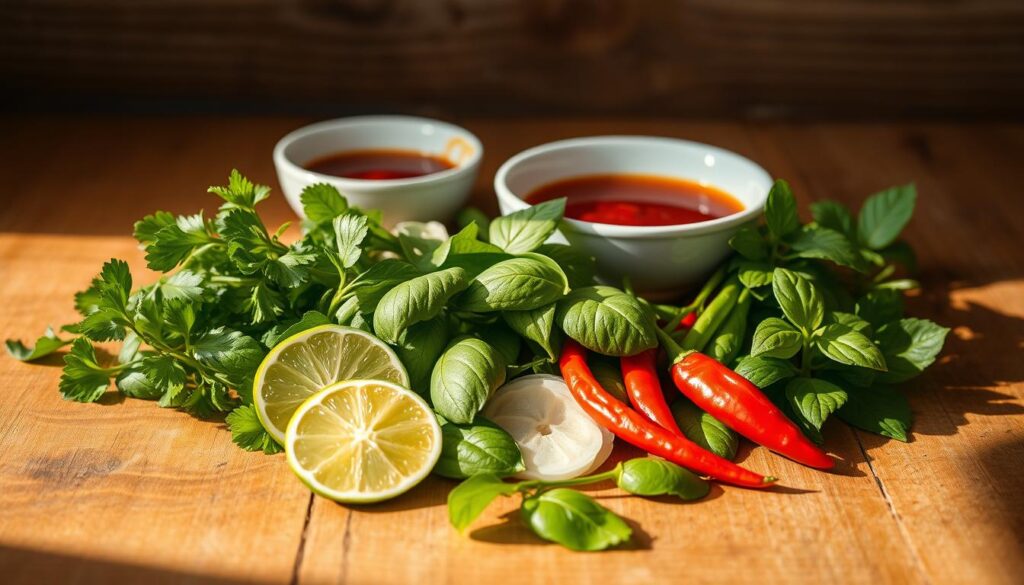
Garnishes are key in traditional pho, making Vietnamese cuisine even better. They let you make your tendon beef pho just right for you.
At authentic Vietnamese restaurants, you get a plate of fresh herbs and veggies. They turn your soup into a special journey. The garnish plate usually has:
- Fresh bean sprouts
- Thai basil leaves
- Lime wedges
- Sliced jalapeño peppers
- Culantro (sawtooth herb)
Each garnish adds something special to your pho. Bean sprouts give crunch, and Thai basil adds a hint of anise. Lime wedges add a zesty touch, and jalapeños bring heat.
Vietnamese cuisine also has unique sauces for pho:
- Hoisin sauce: Sweet and tangy
- Sriracha: Spicy chili sauce
- Fish sauce: Umami-rich seasoning
Try different garnishes and condiments to make your pho just how you like it. The beauty of pho is in its ability to be customized.
How to Serve and Eat Tendon Beef Pho
Eating tendon beef pho is more than just a meal. It’s a journey through Vietnamese cuisine. Learning how to serve and enjoy beef noodles can make your meal unforgettable.
Your tendon beef pho comes hot, ready to delight your senses. The way it’s presented is as important as its taste. It’s a complete experience for your taste buds.
Traditional Serving Techniques
Serving beef noodles the traditional way is a special ritual. It honors the dish’s cultural roots. Here’s how to enjoy it authentically:
- Position your spoon and chopsticks strategically
- Start by appreciating the aromatic broth
- Gently mix the tender beef tendons with noodles
- Add fresh herbs gradually to enhance flavor
Customization Possibilities
Everyone has their own way of enjoying tendon beef pho. You can make your bowl your own:
- Adjust spice levels with sriracha or chili sauce
- Add extra herbs like Thai basil or cilantro
- Squeeze fresh lime for brightness
- Experiment with different condiment combinations
Every bite of tendon beef pho has a story. It’s about tradition, skill, and passion. Enjoy the journey and let your taste buds discover the flavors of Vietnam.
Regional Variations of Tendon Beef Pho
Vietnamese cuisine is rich and varied, with pho being a prime example. Each region in Vietnam adds its own twist to this beloved dish. This makes tendon beef pho a journey of discovery, showcasing local tastes and traditions.
Looking into the regional variations of pho, we find interesting differences:
- Northern Vietnam (Hanoi): The birthplace of traditional pho, known for a clear, delicate broth with few garnishes
- Central Vietnam (Hue): A spicier version with deeper seasoning and bolder flavors
- Southern Vietnam (Ho Chi Minh City): A sweeter broth with lots of herbs and complex garnishes
In the north, pho stays true to its roots, focusing on pure beef flavors and subtle spices. The south adds more herbs like Thai basil, bean sprouts, and extra condiments. This makes the dish more vibrant and exciting.
“Pho is not just a dish, it’s a culinary journey through Vietnam’s diverse landscapes and cultural heritage.”
Knowing about these regional differences helps us see the depth and complexity of Vietnamese cuisine. Each bowl of tendon beef pho shares a story. It’s about local ingredients, cooking methods, and family recipes passed down through generations.
Health Benefits of Beef Tendon in Pho
Beef tendon soup is more than just tasty. It’s packed with nutrients that boost your health and wellness.
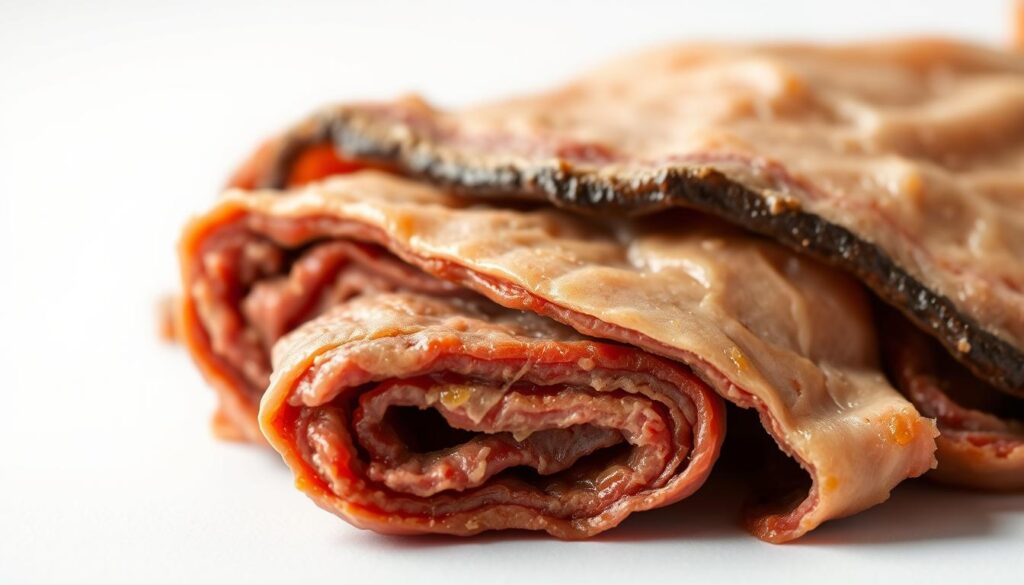
Your favorite beef tendon soup is a nutritional powerhouse. It’s rich in collagen, offering health benefits beyond regular protein.
Nutritional Profile
Beef tendons are surprisingly nutritious. They offer a mix of health-promoting components:
- High protein content supporting muscle development
- Low fat composition
- Rich mineral source including zinc and iron
- Essential amino acids for body repair
Collagen Benefits
Collagen in beef tendon dishes offers great wellness benefits:
| Benefit | Description |
|---|---|
| Joint Health | Reduces inflammation and supports cartilage strength |
| Skin Elasticity | Promotes smoother, more youthful skin appearance |
| Digestive Support | Helps repair intestinal lining and promotes gut health |
Adding beef tendon soup to your diet does more than just satisfy your taste buds. It’s a way to invest in your body’s long-term health and vitality.
Tips for Finding the Best Pho Restaurants
Finding a great pho restaurant can make your meal unforgettable. Look for signs of a top spot and use insider tips to guide you.
Here are important signs of a great pho place:
- Bustling environment with diverse clientele
- Clear, aromatic broth that looks rich and transparent
- Fresh herbs and garnishes displayed prominently
- Chefs with visible Vietnamese culinary heritage
When choosing a pho spot, pay attention to what you see and smell. A top restaurant will show:
| Quality Indicator | What to Look For |
|---|---|
| Broth Quality | Deep amber color, no excess oil, complex aroma |
| Meat Preparation | Thinly sliced, fresh-looking cuts |
| Tendon Texture | Soft yet slightly chewy, not rubbery |
Pro tip: Ask staff about their cooking methods and where they get their ingredients. They’ll share their passion for pho.
“A great pho restaurant is like a culinary passport to Vietnam” – Traditional Vietnamese Chef
Your ideal pho place should feel warm, smell amazing, and stick to traditional ways. Trust your senses and enjoy finding the best Vietnamese food.
Common Mistakes to Avoid When Making Pho
Making perfect homemade pho broth needs skill and care. Many struggle to get the real flavor and texture of traditional beef tendon soup. Knowing common mistakes can help you improve your pho-making skills and make a dish that tastes like it’s from a restaurant.
Creating an amazing homemade pho broth requires careful attention. Most mistakes come from rushing or not using the right techniques. Let’s look at the main mistakes to avoid:
Broth Preparation Pitfalls
- Rushing the simmering process for your homemade pho broth
- Using low-quality bones or incorrect meat cuts
- Failing to skim off excess fat during cooking
- Oversalting or under-seasoning the broth
When making your beef tendon soup, be patient. The broth needs slow, careful simmering to get the best flavor. Skimming off impurities and using high-quality bones makes a big difference.
Tendon Cooking Challenges
- Improper cleaning of beef tendons before cooking
- Overcooking or undercooking tendons
- Neglecting to tenderize tendons properly
- Incorrect seasoning of the meat
Pro tip: Beef tendons need special care. They must cook slowly to become tender and right in texture. Blanching before cooking helps remove impurities and makes the soup clean and tasty.
By knowing these common mistakes, you can make a pho that’s as good as a restaurant’s. With practice and patience, your homemade pho broth will go from good to great.
Conclusion
Tendon beef pho is more than a meal; it’s a journey through Vietnamese cuisine. It connects you to generations of tradition. Each bowl tells a story of careful preparation, cultural heritage, and amazing flavors.
Exploring tendon beef pho shows it’s more than just food. You’ve learned about its history and how to make the broth. The mix of tender beef, spices, and broth makes every bite special.
Whether you cook at home or eat out, tendon beef pho is unique. It invites you to explore this culinary tradition further. Try new techniques and discover the depth of Vietnamese cuisine.
Your food adventure is just starting. It’s a journey of taste, culture, and passion. Keep learning, cooking, and enjoying every moment of your tendon beef pho journey.
FAQ
What exactly is beef tendon pho?
Beef tendon pho is a traditional Vietnamese noodle soup. It has tender beef tendons in a rich, aromatic broth. The tendons are slow-cooked until they’re soft and gelatinous.
This adds a unique texture to the classic pho dish. It’s a flavorful twist on traditional pho, offering a more complex and hearty experience.
How long does it take to properly cook beef tendons for pho?
Cooking beef tendons takes patience. You’ll need to simmer them for 3-4 hours. This makes them tender and soft.
The slow cooking breaks down tough connective tissues. It turns the tendons into a soft, flavorful part of the dish.
Are beef tendons nutritionally beneficial?
Yes, beef tendons are nutritious. They’re rich in collagen, which is good for joints and skin. They also provide protein and minerals.
While low in fat, tendons are high in protein and minerals. They’re valued for their potential to support connective tissue health.
Is tendon beef pho spicy?
Traditional tendon beef pho is not spicy. But, you can add heat with chili peppers or sriracha. The broth focuses on complex flavors, not intense heat.
How can I tell if a restaurant serves authentic tendon beef pho?
Look for clear, flavorful broth and fresh herbs. The beef tendons should be tender and prepared traditionally. Vietnamese restaurants use spices like star anise and cinnamon.
They serve the pho with fresh bean sprouts, Thai basil, and lime. These are signs of authentic Vietnamese pho.
Can I make tendon beef pho at home?
Absolutely! Making tendon beef pho at home is possible with the right ingredients and patience. You’ll need high-quality beef bones, spices, and fresh herbs.
It takes several hours to develop the rich broth. The key is slow simmering and careful seasoning. Start with a good recipe and practice to perfect your technique.
What’s the difference between tendon beef pho and regular beef pho?
The main difference is the meat. Tendon beef pho has slow-cooked beef tendons. These are softer and more gelatinous than regular beef slices.
The tendons add a unique texture and flavor. This sets tendon beef pho apart from traditional beef pho.
How should I eat tendon beef pho?
Traditionally, use chopsticks and a spoon. Add fresh herbs and garnishes to taste, then mix them into the hot broth. Use chopsticks for noodles and meat, and a spoon for the broth.
Customize with sauces like hoisin or sriracha to your liking.
